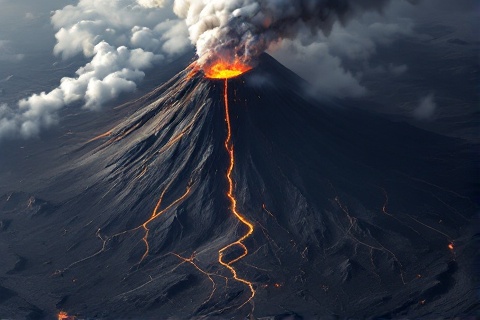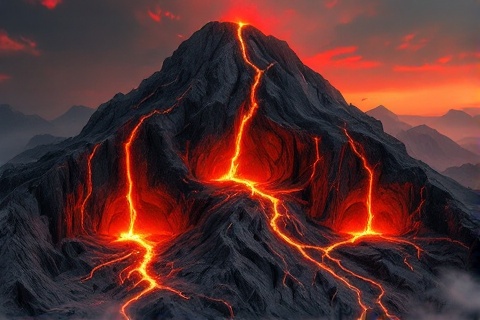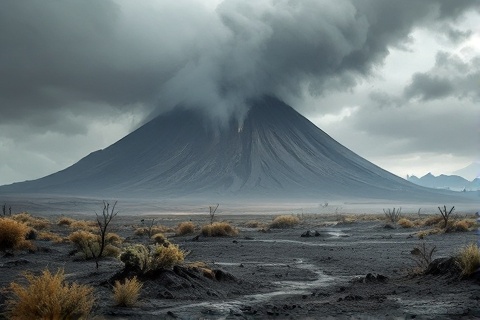
Orodruin: The Fiery Heart of Mordor
Unveiling the Secrets of Mount Doom in Tolkien's Legendarium
The Geography of Orodruin

Orodruin, the great volcano of Mordor, rises from the vast
Plateau of Gorgoroth like a looming sentinel of darkness. Located approximately
100 miles from the Black Gate and positioned centrally within Mordor's
heartland, this fearsome mountain stands as the geographic and spiritual center
of Sauron's realm. The volcanic peak is surrounded by a
desolate plain of ash and rock, with the Dark Tower of Barad-dûr lying some
forty miles to the northeast, connected to the mountain by a great causeway.
The mountain presents an imposing figure, reaching thousands of feet into the
smoky skies of Mordor. Its distinctive conical shape, typical of composite
volcanoes, features steep slopes that rise sharply from the surrounding plateau.
The upper reaches of Orodruin assume a more cylindrical form, topped by a crater
that constantly emits fumes and occasionally spurts flame into the dark sky
above.
The internal structure of Orodruin is a complex network of magma chambers and
volcanic vents. Multiple secondary cones and fumaroles dot its slopes, releasing
toxic gases and steam. The mountain's primary magma chamber lies deep beneath
the surface, feeding smaller chambers that supply the various vents and fissures
throughout the volcano. Ancient lava tubes and solidified magma passages create
a labyrinthine system within the mountain's core.
The Mountain's Many Names
The name 'Orodruin' comes from the Sindarin language, combining the elements
'orod' meaning 'mountain' and 'ruin' meaning 'fiery red.' This name reflects
both the mountain's nature as a volcano and its significance as a place of
burning flame. The Elves gave it this name during the Second
Age, when Sauron first chose it as the site for forging the
One Ring.
The more commonly known name 'Mount Doom' is the direct translation of 'Amon
Amarth' in Sindarin, given to the mountain by the Gondorians.
This foreboding name reflects the dread and doom that the mountain represented
to the Free Peoples of Middle-earth, as it became
inexorably linked with Sauron's power and the fate of the One Ring. The name
proved prophetic, as the mountain indeed became the place where the doom of the
Ring, and consequently Sauron, was finally achieved.
Throughout the languages of Middle-earth, Orodruin bore many names that
reflected its fearsome nature. In Westron, it was called the Fiery Mountain,
while in Quenya it was known as Nárassë. The Orcs of Mordor
referred to it in their Black Speech, though these names are not recorded in the
surviving histories. Each name emphasized the mountain's association with fire,
destruction, and the power of Sauron.
The Fiery Heart

Deep within Orodruin, eternal fires burn with supernatural intensity, their
flames fed by both natural volcanic processes and the lingering power of
Sauron's greatest works. These fires maintain temperatures far hotter than
ordinary volcanic activity would suggest, creating conditions that made possible
the forging of the One Ring. The mountain's heart glows with an ever-present red
light that can be seen through cracks and vents in its surface, especially at
night.
The Great Fire Chamber represents the most terrifying aspect of Orodruin's
internal structure. This vast cavern, located deep within the mountain, contains
a lake of perpetually molten rock that never cools or diminishes. The chamber's
ceiling rises hundreds of feet above the molten surface, creating an immense
space where the very air shimmers with heat. The fires here burn with particular
intensity, maintained by forces both natural and supernatural.
Throughout the mountain's structure, an intricate system of natural tunnels and
volcanic vents channels heat, gases, and occasionally lava to the surface. These
passages, carved by millennia of volcanic activity, create a complex network
that regularly releases pressure from the mountain's core. Some of these vents
produce constant streams of noxious fumes, while others remain dormant until
periods of increased activity. The largest of these vents opens into the Sammath
Naur, the Chambers of Fire, where the One Ring was forged.
The Sammath Naur

The entrance to the Crack of Doom consists of a dark door cut into the eastern
face of Orodruin, opening onto a long tunnel that leads into the heart of the
mountain. This tunnel, roughly hewn and ancient, was originally carved by
Sauron's servants to access the great forge-chamber within. The path to this
door follows a treacherous road that winds up the mountain's eastern slope,
engineered with remarkable skill despite its fearsome location.
The Chambers of Fire lie high in the mountain's eastern face, positioned
approximately two-thirds of the way up Orodruin's height. This strategic
location provides the chamber with intense heat from the volcano's core while
remaining accessible via the carved tunnel. The precise positioning allows the
chamber to draw upon the mountain's maximum geological power while maintaining
enough structural stability to prevent collapse.
The Crack of Doom itself is a vast fissure within the main chamber, plunging
deep into the heart of the mountain. This great chasm contains a river of molten
rock far below, visible as a glowing red line in the darkness. The chamber's
walls are smooth and sheer, having been shaped by both natural forces and
ancient craft. The heat within is nearly unbearable, and the air is thick with
toxic fumes that rise from the molten rock below.
Environmental Impact on Mordor

Orodruin's constant volcanic activity profoundly affects the climate of Mordor,
creating a microclimate of extreme conditions around the mountain. The volcano's
emissions of ash, smoke, and toxic gases contribute to a perpetual haze that
hangs over the Plateau of Gorgoroth. This atmospheric contamination results in
acid rains that further poison the already barren soil, making normal plant life
impossible in the regions surrounding the mountain.
The landscape of Gorgoroth bears the unmistakable marks of Orodruin's influence,
with layers of ash and volcanic debris covering everything for miles around. The
plateau's surface consists of broken rock, solidified lava flows, and drifts of
volcanic ash that shift in the hot winds. No vegetation grows in this desolate
region, and the ground itself is often hot to the touch due to the geological
activity beneath the surface.
The mountain plays a crucial role in maintaining the perpetual darkness that
shrouds Mordor. The combination of its volcanic emissions with Sauron's sorcery
creates an impenetrable barrier of clouds and smoke that blocks out the sun.
This unnatural darkness extends far beyond Mordor's borders, affecting weather
patterns throughout the surrounding regions and contributing to the oppressive
atmosphere that characterizes Sauron's realm.
Geological Activity Patterns

Orodruin exhibits distinct patterns of volcanic activity, alternating between
periods of relative quietude and intense eruption. During its dormant phases,
the mountain continues to emit smoke and fumes, but its more violent activities
subside. These cycles appear to follow natural geological rhythms, though they
can be influenced by external forces, particularly the power and will of Sauron.
When fully active, Orodruin's eruptions display tremendous force and intensity.
The mountain spews forth great clouds of ash and smoke that can darken the sky
for hundreds of miles. Rivers of lava flow down its slopes, and explosive events
throw volcanic bombs and debris high into the air. These eruptions are
accompanied by earthquakes that can be felt throughout Mordor and even beyond
its borders.
The mountain's volcanic activity shows a clear correlation with major events in
Middle-earth, particularly those connected to Sauron's power. During the War of
the Ring, Orodruin's activity intensified significantly, reaching its peak
during the final days before the Ring's destruction. The mountain's ultimate
eruption, which accompanied the Ring's unmakiing, was its most catastrophic,
resulting in the complete destruction of its upper portions and the
restructuring of the surrounding landscape.
